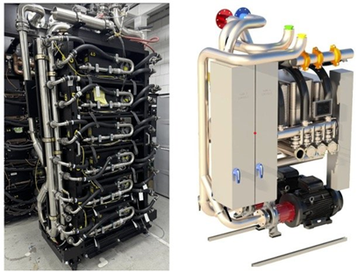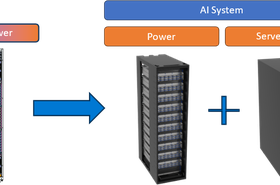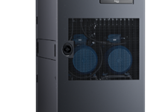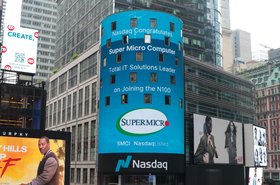Google has joined Meta and Microsoft’s collaboration project on a power rack the companies hope will help them reach rack densities of 1MW.
Representatives from Google, Meta, and Microsoft this week took to the stage at the 2025 OCP EMEA Summit in Dublin to discuss the previously announced Mount Diablo project; a new power rack side pod that the companies say will enable IT racks to reach densities of up to 1MW.
This week also saw Google announce that it will contribute the specs of its fifth-generation cooling distribution unit, Project Deschutes, to OCP.
Higher density racks see hyperscalers move to disaggregate power from IT
At the OCP event in Dublin this week, all three companies reiterated that racks with AI-focused IT hardware could reach more than 500kW each before 2030, and 1MW not long after. In such a scenario, space in such highly dense racks will be at a premium.
To accommodate this, the companies are turning to a much higher voltage DC power distribution solution, where power components and battery backup are outside of the IT rack.
Mount Diablo is an AC-to-DC sidecar power rack that disaggregates power components from the IT rack. The system notably aims to allow AC inputs to be converted into 400V DC.
Meta and Microsoft first announced they were collaborating on the project back in November. Google is now collaborating with the pair, with all three set to release details to the OCP community.
The companies are collaborating and publishing specs to OCP in order to standardize the electrical and mechanical interfaces. The project’s 0.5 specification draft will be available for industry feedback in May.
Google has been using 48V DC in many of its racks for more than a decade, but the company suggests this new solution will improve the end-to-end efficiency by ~ 3 percent while enabling the entire IT rack to be used for xPUs (a collective term for GPUs and other AI accelerator chips).
“[48V DC] served us very well between 10kW and 100kW a rack,” Madhusudan Iyengar, principal Engineer at Google, told the audience at OCP this week. “But we think that’s going to change.”
One reason for this, he said, was the company’s prediction that we will see densities of greater than 500kW in a rack by 2030. The second reason is that “there is a lot of competition for every millimeter cubed of space in the rack, which means you’re going to to have to push out some of the supporting infrastructure from inside the rack to outside the rack.”
“Longer term, we are exploring directly distributing higher-voltage DC power within the data center and to the rack, for even greater power density and efficiency,” the company added in a follow up blog.
Microsoft has previously announced a liquid cooling sidepod that can be installed into existing data centers and not attached to the facility’s water system, which is designed to sit next to racks of AI accelerators.
Meta debuted a new liquid-cooled rack designed to host Nvidia Blackwell chips last year, known as Catalina, that was able to support up to 140kW.
During his talk, Meta senior director of infrastructure, Ola Tørudbakken, suggested the company was looking at moving towards double-wide racks.
“What we see as a natural extension, is that we move from single racks to double-wide racks,” he said on stage. “The typical physical footprint is 1,200 by 1,200 millimeters, which can easily be deployed in our data centers, but also external data centers.”
Google to release specs for Project Deschutes CDU
This week also saw Google promise to release the specs of its latest upcoming cooling distribution.
During his OCP talk this week, Iyengar said Google has been using liquid cooling since launching the third iteration of its Tensor Processing Unit (TPU) back in 2018.
Today, the company Iyengar said around half of Google’s global data center footprint has liquid cooling enabled and/or deployed. In total, the search giant has deployed around 1GW of liquid cooling capacity across some 2,000 TPU pods – with an uptime of 99.999 percent. The company announced its latest generation of TPU – known as Ironwood – last month.
Google’s cooling systems utilize in-row coolant distribution units (CDUs) with redundant components and uninterruptible power supplies (UPS). The CDUs isolate the rack’s liquid loop from the facility loop.
“In our CDU architecture, named Project Deschutes, the pump and heat exchanger unit is redundant, which is what has enabled us to consistently achieve the above-mentioned fleet-wide CDU availability of ~99.999 percent since 2020,” the company said in a blog post.
This week Google said it will contribute the fifth-generation of its Project Deschutes CDU, currently in development, to OCP later this year.
The contribution will include system details, specifications, and best practices; the search giant said the move is intended to help accelerate the industry’s adoption of liquid cooling at scale.
“ We… strongly encourage the industry to adopt the Project Deschutes CDU design and leverage our extensive liquid cooling learnings,” the company said. “Together, by embracing these advancements and fostering deeper collaboration, we believe the most impactful innovations are still ahead.”
The company didn’t share any information about the planned roll-out of the new CDU across its portfolio.
Meta develops liquid-cooled busbar
During a separate OCP talk this week, Meta detailed its plans for upcoming generations of high-powered rack (HPR) hardware specs it aims to release to the community.
The current version of the spec, HPRv2, aims to support up to 190kW per rack in a single integrated design.
The next version of the design, HPRv3, will support up to 300kW and utilize a disaggregated side power pod that will host the power supply unit (PSU) and battery backup (BBU) shelves. This design will include a new liquid-cooled busbar running vertically down the rack, as well as busbars connecting the power rack to the IT rack.
The new design features copper tubes/coldplates running along the length of the busbar, with a thermal interface material between the tubes and busbar copper.
The social media giant said the current HPR busbar design can support up to 155kW. The new liquid-cooled version, first tested in September, could support up to 700kW. Capacities above 700kW might be possible through increased busbar depths and additional coldplates.
Version 4 of the HPR rack will utilize 400V DC power and will aim to support rack densities up to 800kW with plans to expand to 1MW in the future. That design will use power cables instead of busbars to connect the power rack and the IT rack.
V3 of the HPR rack and plans for a liquid-cooled busbar were first announced in October.
Read the orginal article: https://www.datacenterdynamics.com/en/news/hyperscalers-prepare-for-1mw-racks-at-ocp-emea-google-announces-new-cdu/









